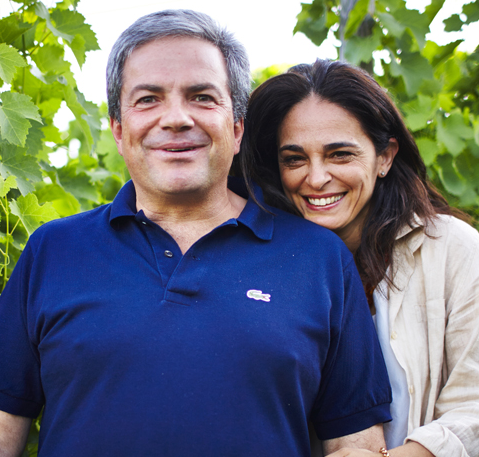
Across the bay from the honey pot of Positano you will find the vineyards of Luigi Maffini near the Greek ruins at Paestum.
We are on the coast of Cilento DOC. The breezy coastal vineyards are very different from warmer inland sites in Campania, where the volcanic soil is also richer and more fertile. Luigi’s father established the vineyard using the local grapes – lightly spicy and floral white Fiano and the burly red Aglianico.
Luigi and his wife Raffaella went to Naples university to study agricultural science and now they manage their vineyards organically. There are two sites – Catellabate and Giungano – hence some wines fall into the DOC of Cilento and others into DOC Paestum, named after the ancient Greek site which has in turn inspired the classic Greek names of their wines.

And so what of these two local varieties?
Fiano is an ancient variety, grown in Campania for hundreds of years, first mentioned in the C13th. These days it’s become rather fashionable. It has a light nutty character with a touch of fennel. It is medium bodied with decent acidity and light spicy and floral notes. However it could be easily missed in a crowd. Italian whites can often seem self effacing. Their primary role is to accompany food and they get on with it with no fuss. Fiano is restrained, but quite special and is a sommelier’s best friend. You’ll find a Fiano on any self-respecting wine list these days.
Aglianico is a macho red variety. A burly grape of the hot south. Lots of robust tannin and dark, rich chocolatey fruit. Plentiful acidity. The temperament of this powerful wine is quite the the opposite of Fiano and when it’s made in an old school more extractive style, it can be bullish and take a while to settle down and mature. As the tannins soften it develops more tertiary characters of leather, coffee with bresaola and earthy undertones.
In their coastal vineyards Luigi and Raffaella are seeking to elevate Fiano to become a bit more showy, while they are down playing Aglianico – on the premise that less is more with Aglianico
And the two sites? One is on a hill at 380 meters with a western exposure and clay limestone soils and the vines are very low yielding, while the second is more fertile. The first was planted in 1997. It’s nearer to the the sea, there is less clay and it contains some sand and stones.
Let’s get tasting

Kratos
This fiano is fermented in stainless steel. The grapes are from both sites and are kept separately, beginning fermenting in stainless steel before being blended to finish together.
2016 Maffini Kratos
A light and slightly spicy white wine with just nicely balanced acidity. It has a hint of just ripe apricot and a somewhat savoury fennel character on the finish.
2013 Maffini Kratos
This illustrates that Fiano becomes more interesting with a few years in bottle as this shows slight Riesling aromas with kerosene notes and has a light bite of salt at the end.
Pietraincatenata
This Fiano is a selection from Luigi’s best vineyard. After starting fermentation in steel tanks, the blend is transferred to French oak to finish fermentation. It does not stay there too long. Just 3 months for the oak could easily dominate. It may seem a tad extravagant to use expensive new barrels for just a few months, but they are used in following years for the reds. Pietraincatenata gets quite a lot of bâtonnage. Luigi said he stirs it three times a month.
2016 Maffini Pietraincatenata
This is quite full and has rich spiciness. The enthusiastic bâtonnage has certainly given the wine a thick texture and exacerbates the naturally nutty notes of the grape with leesy notes. The acidity is well balanced and the finish firm.
2014 Maffini Pietraincatenata
2014 was wet during the summer and rained before harvest, diluting the grapes, making this a lighter vintage. It has an engaging savoury character combining notes of hay and fennel and the finish is rather elegant with a touch of vibrancy at the end.
Clearly Fiano is a grape that can be enjoyed young & lovely with seafood. However it’s worth giving it three or four years to realise the more interesting mature notes. The 2011, a rich vintage, was good, but dropped off a bit on the finish, so don’t leave them too long.
Now to the reds and these are not shy.

You may be familiar with the rather robust wines from the red grape Aglianico. It’s well sited to the warm climate in Campania and Basilicata and is quite a bruiser. Its thick skins typically give a lot of tannin. It can seem a bit aggressive as those tannins are accentuated by its naturally high acidity and traditional made wines can take an age to come around.
However Luigi seeks a different profile from his coastal vineyard. He admits he cannot change the character of the grape, but he seeks to civilise it and highlight the fruit and he has certainly made a more accessible style.
Luigi is very selective with his berries. There are two triage tables – one to de-select the unwanted bunches and a second vibrating table for the less than perfect berries – only the best will do.
Kleos
His first wine is focused on fruit. It is all de-stemmed and has a pretty short maceration – barely flying past its skins so as not to extract too much tannin. After 5 days it’s pressed off and goes to stainless steel to do MLF before 9 months ageing in older oak.
2015 Maffini Kleos
This is very accessible – a delicious, fruity style, medium bodied, very juicy, with a hint of bitter cherry and soft easy tannins. I could sit in the shade and drink this all day.
Cenito
In the best vintages Luigi makes his special cuvée of Aglianico. This is a selection of his oldest vines, which were planted in the 1970s and located 2-3 km from the sea. With this fruit he pushes extraction to ten days using some remontage and a couple of rack and returns.
2011 Maffini Cenito
This is rich with ripe blueberries and blackberries. It is full bodied, but not heavy. The tannins are substantial, but soft. There is an comforting chunkiness to the texture. It is slightly spicy showing a touch of coriander and cinnamon and the lovely rich, bitterness of dark chocolate. This is a young wine. You could drink it now, as the tannins are mellow and the fruit so inviting, but it is still on the fruity side and will become more complex with age. Give it a few years and savour the rewards.
2014 Maffii Cenito
2014 had quite a lot of rain and was not as hot as sunny 2011. The wine is lighter, less dense, but more elegant. The tannins are smooth, the texture slimmer, but make no mistake this is still a burly wine from the South. There is the dark richness and a nice freshness; a light bitter bite, a dusting of cocoa – it’s less spicy and more salty.
The English Nose enjoyed this sorte to Campania to sniff out two excellent grape varieties. Steeped in Greek history, this is a region with a long history of winemaking, but also an innovative and lively present. There is a place for the old style and the new. Luigi and Raffaella are part of a modern wave who have successfully elevated their Fiano and tamed their Aglianico. Hurrah.
Stockist
Lea and Sandeman (Chelsea, Kensington, Barnes and Chiswick)
2016 Kratos £18.95 (price per bottle case equivalent £16.95)
2016 Pientraincatenata £27.50 (price per bottle case equivalent £24.75)
2015 Kleos £19.95 (price per bottle case equivalent £17.95)
2011 Cenito £37.50 (price per bottle case equivalent £33.75)

